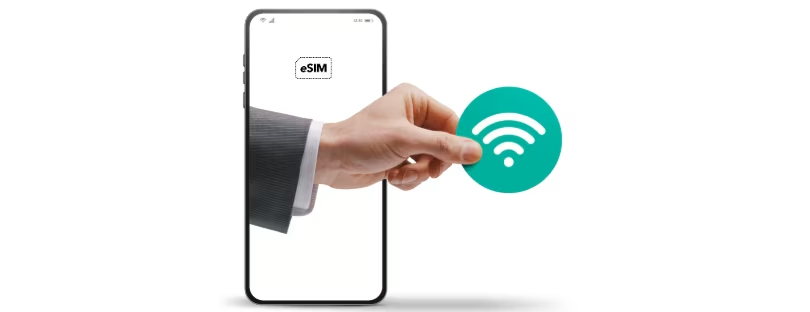
eSIM vs. WiFi: When You Need It and When You Don’t
In today’s world, where technology seems to evolve every time we blink, the eSIM has become a hot topic. It’s convenient and versatile and is steadily replacing the traditional physical SIM card we’ve all been using for years. But with this new technology comes a lot of questions, and one that’s been popping up a lot lately is: Can eSIMs work without WiFi?
Let’s break this down in a conversational way so you get the full picture without needing a tech degree.
What Exactly Is an eSIM?
Before we dive into whether or not WiFi is a must-have for eSIMs, let’s quickly cover the basics. An eSIM (embedded SIM) is a small chip embedded directly into your phone or other devices. Unlike the traditional SIM cards that you physically insert into your device, an eSIM is built into the hardware. It doesn’t need to be swapped out or physically replaced when you change carriers.
The magic of eSIMs lies in their flexibility. You can switch carriers, manage multiple profiles, or activate a new plan without having to fiddle with tiny cards or visit a store. Everything is done digitally—cool, right?
So, Does an eSIM Actually Need WiFi?
Now, let’s answer the burning question: Do eSIMs require WiFi? The short and sweet answer is no. But—of course—there’s a bit of nuance here.
Here’s the thing: eSIMs themselves don’t rely on WiFi to function. Once your eSIM is activated and your phone is connected to your mobile carrier’s network, it works just like a regular SIM card. You can make calls, send texts, and browse the internet using your mobile data. WiFi has no role in the day-to-day operation of your eSIM.
However, there are moments in the eSIM lifecycle when WiFi (or some form of internet connection) might be needed. Let’s unpack those situations.
When Do You Need WiFi for eSIMs?
1. During the Initial Setup or Activation
Most eSIMs require an internet connection—whether through WiFi or mobile data—when you first set them up. This is because the eSIM profile (essentially, your carrier’s digital plan) needs to be downloaded onto your device.
Think of it like downloading an app. Your phone connects to the internet to fetch the profile and install it. This process is typically quick and seamless, but it does require that initial connection.
2. Switching Between Carriers or Plans
One of the coolest features of eSIMs is the ability to switch between carriers or plans without swapping SIM cards. However, when you do this, you’ll often need an internet connection to download the new carrier profile. Again, this could be done using either WiFi or your existing mobile data plan.
3. Traveling Internationally
If you’re traveling and want to use a local carrier’s eSIM plan, you might need WiFi to download and activate the new plan. This is especially true if you’re in a country where your existing mobile data isn’t working yet.
What Happens if You Don’t Have WiFi?
If you find yourself in a situation where you don’t have access to WiFi, don’t worry—you’re not completely out of luck. Here are a few scenarios and tips to help you out:
1. Use Mobile Data for Activation
Many devices allow you to use mobile data to activate your eSIM. This is super handy if you’re somewhere without WiFi but still have a working mobile connection. Just make sure you’re not roaming internationally with exorbitant data charges before attempting this!
2. Visit a Retail Store
If you’re unable to connect to the internet for any reason, many carriers offer the option to activate an eSIM in-store. A representative can assist you with downloading the profile and setting it up for you.
3. Preload an eSIM Profile
Some carriers let you preload an eSIM profile onto your device before you need it. This is particularly useful for travelers. You can download the eSIM profile in advance (when you have access to WiFi) and activate it later, even without the internet.
How Do eSIMs Work Without WiFi After Activation?
Once your eSIM is up and running, it’s business as usual. The eSIM connects directly to your carrier’s network, just like a traditional SIM card would. You don’t need WiFi to:
- Make or receive calls
- Send or receive texts
- Use mobile data
In fact, after activation, you can completely forget about needing WiFi for your eSIM. It becomes just another part of your phone’s hardware, working in the background to keep you connected.
Are eSIMs better than traditional SIM cards?
If you’re still on the fence about eSIMs, let’s take a quick look at the pros and cons compared to traditional SIM cards.
Advantages of eSIMs:
- Convenience: No need to fiddle with physical SIM cards or worry about losing them.
- Flexibility: Easily switch between carriers or plans, even on the go.
- Space-saving: Without a SIM card slot, manufacturers can use that space for other cool features (like bigger batteries!).
- Eco-friendly: No plastic SIM cards mean less waste.
Disadvantages of eSIMs:
- Setup can require internet: As we’ve discussed, you might need WiFi or mobile data for initial activation or switching profiles.
- Not universally supported: While most modern phones support eSIMs, not all carriers or regions do.
- Less tactile: Some people like the physical act of swapping SIM cards—it feels more tangible.
Practical Tips for eSIM Users
If you’re ready to dive into the world of eSIMs, here are a few practical tips to make the transition smoother:
- Check Compatibility: Ensure your device and carrier support eSIMs before making the switch.
- Keep a Backup Plan: If you’re traveling, download an eSIM profile in advance or keep a physical SIM card as a backup.
- Know Your Limits: Some carriers place limits on the number of eSIM profiles you can store or switch between—check the details with your provider.
- Secure Your Device: Since eSIMs are tied to your device, losing your phone could mean losing access to your plan. Make sure your phone is secure with a strong password or biometric lock.
The Future of eSIMs: More Connectivity, Fewer Hassles
The rise of eSIM technology signals a shift toward more seamless and flexible connectivity. While there are still a few quirks to work out (like the occasional need for WiFi during setup), eSIMs offer a glimpse into a future where staying connected is easier than ever.
So, can eSIMs work without WiFi? Absolutely. While WiFi might be needed for specific tasks like activation or switching carriers, your eSIM will function just fine without it once everything is set up. It’s just one more way technology is making our lives a little more hassle-free.
What are your thoughts on eSIMs? Have you made the switch, or are you sticking with traditional SIM cards for now?










